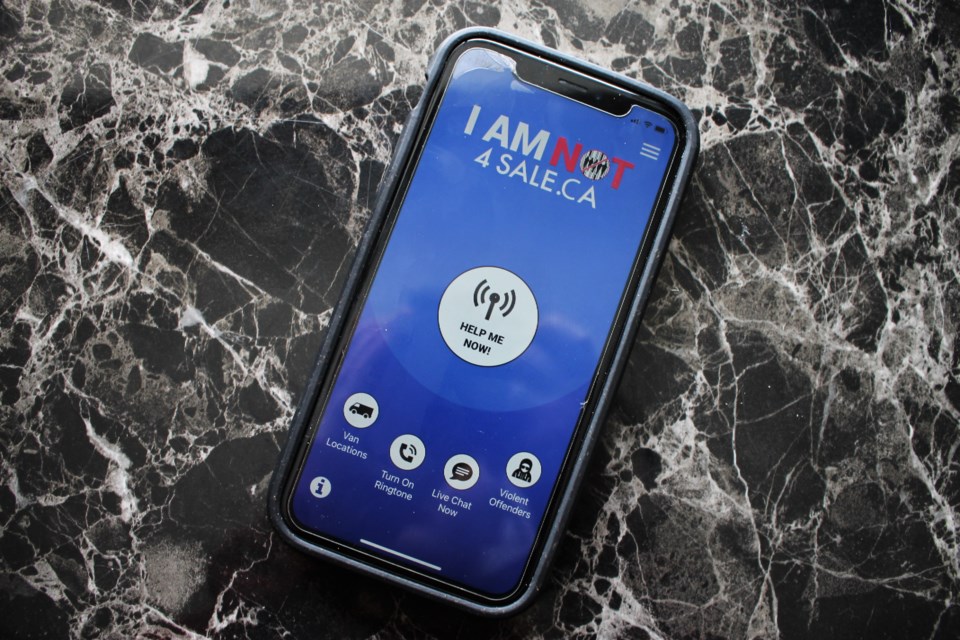SASKATOON — EGADZ Saskatoon and development partners unveiled a newly revamped version of its mobile app I Am Not 4 Sale, with the intent of ensuring safe emergency support is just a few finger taps away for vulnerable Saskatchewan youth.
The free-to-use app aims to more easily connect youth in Saskatchewan experiencing things like sexual exploitation, mental health concerns and other potentially dangerous situations with emergency personnel and counsellors.
The I Am Not 4 Sale app was originally developed and launched by the non-profit youth centre a few years ago, but executive director Don Meikle said the idea was in need of some big updates.
The new and improved app and accompanying website relaunched on March 18, thanks to a funding commitment from the provincial government and a partnership with Saskatoon developer Push Interactions.
Meikle called the new app a “game-changer” to the way youth are able to connect with support services. I Am Not 4 Sale aims to help youth stay anonymous and discreet when requesting services, said Meikle, in order to protect their safety and security.
“It’s a really amazing thing. It's new, it's innovative,” said Meikle. “Sexual exploitation — in Saskatoon, Saskatchewan, Canada, all over the world — and human trafficking is here [and] hopefully this will save those kids. If we can save one kid, it will have been worth it.”
The spotlighted feature of the new version of the app is its emergency call option, which discreetly but immediately connects users with EGADZ staff for help if they find themselves in potentially dangerous situations.
Once activated, users can explain what’s going on via chat messaging and share their location with staff, either for a response from EGADZ outreach workers or from police.
Users can also track the EGADZ mobile support vans in real time, chat with on-duty counsellors and access support information that includes up-to-date police advisories and contact info for local emergency services or hospitals.
At least two staff members are always monitoring the app, said Meikle, offering round-the-clock chat support and emergency response services.
Due to its nature, Meikle said the app’s services are open not just to Saskatoon users, but to youth anywhere in the province needing help.
EGADZ staff are available to offer counselling services through the chat to anyone, anywhere, said Meikle, and Push Interactions CEO Chad Jones explained that because the mobile app utilizes phone location services, help requests can feasibly come from anywhere in the world.
“As long as they have an internet connection, we would be able to triangulate where that person is, see them on the map, and go from there,” said Jones.
While EGADZ outreach workers are limited to responding in-person to calls for aid within Saskatoon, the app’s moderators can contact local police services anywhere to attend to a user’s request for help.
Eight youth involved with EGADZ programming helped to design the new app, offering their input to tech developers and the sexual exploitation intervention committee at the outreach, said Meikle.
Meikle said ultimately, the app’s final design and features were designed by and for its intended user demographic, from function right down to colour scheme.
“They thought of a lot of things that [the committee] never even thought about, as part of the design,” said Meikle.
Previous iterations of the app included bright colours, like a vibrant pink landing screen, but youth consultants said more subtle colours were actually preferable for safety, to avoid drawing attention when users open the app and use it.
For similar reasons, the app also features a ringtone simulator to mimic an incoming call, for users to activate when they’re walking alone or in need of escaping a situation before it escalates.
“It's really designed with them in mind,” said Meikle.
Outreach workers at EGADZ wanted to provide a safe, immediate option for youth to reach out for help and the goal, he continued, was to form-fit the app to best serve the lived experiences of youth who are at risk of sexual exploitation.
“We have to continually work together as a community, with police and with social services and health, to ensure we provide these services for them,” said Meikle. “Because they keep dying, if we don’t, and I think this app is just another step in the right direction to help these kids.”
Meikle said that while the sexual trafficking scene in Saskatchewan has changed some since the 90s, it's still a concern — and it's a situation that can roll up on youth extremely quickly.
“I’ve seen young people go from being normal, kind of vulnerable kids to getting hooked up in the sex trade and it's like, ‘Wow, it's that fast',” said Meikle.
Since the EGADZ sexual exploitation intervention committee began meeting more regularly, Meikle said outreach staff have identified several underage youth working on the streets in Saskatoon. With the advent of social media, Meikle said that sometimes seeing the individuals in these situations has become possibly even more difficult.
“They can get a call on any of the chat lines, or whatever, and they’ll go do their business and nobody knows about them,” said Meikle. “They’re kind of like these hidden kids.”
Meikle said he hopes to see all youth consider downloading the app, to use as a support system.
“If they’re in trouble or if they maybe want to self harm, or they’re in a bad situation, they can call us and we’ll respond,” said Meikle.
The updated version of I Am Not 4 Sale is out and available to download, said Meikle, with a direct QR code to the app on applicable app stores featured on the front page of the new website.




